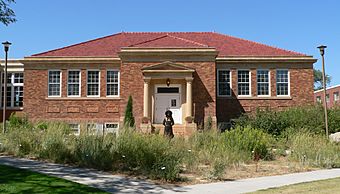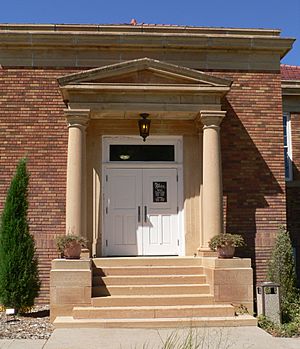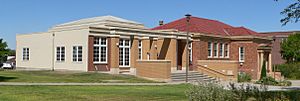Mari Sandoz High Plains Heritage Center facts for kids
Quick facts for kids |
|
|
Library
|
|

Sandoz Center: historic library building, with statue of Sandoz in front
|
|
| Location | Chadron State College campus, Chadron, Nebraska |
|---|---|
| Built | 1929 |
| Architect | J. C. Stitt |
| Architectural style | Classical Revival |
| MPS | Chadron State College Historic Buildings TR |
| NRHP reference No. | 83001084 |
| Added to NRHP | September 8, 1983 |
The Mari Sandoz High Plains Heritage Center is a special museum. It celebrates the life and writings of an author named Mari Sandoz. This center also teaches about the High Plains region. This is a large area in the western United States. Mari Sandoz grew up there, and many of her stories were set in this region.
The Center is located at Chadron State College in Chadron, Nebraska. It is in the college's old library building. This building is so important that it is listed on the National Register of Historic Places.
Contents
Discovering the Center's History
Chadron State College: A Brief Look
In 1909, the state of Nebraska decided to build a new school. This school was called a "normal school." It was a place to train teachers. The Nebraska Board of Education chose Chadron as the location in 1910. Classes started in the summer of 1911 with 111 students.
In 1921, the state changed the normal schools to "teachers colleges." By 1963, the school became known as Chadron State College. This is its name today.
Early Buildings at Chadron State
From 1911 to 1938, seven main buildings were built on the campus. After that, no big new buildings were added until 1953. The first building was the Administration Building, started in 1910. Other early buildings included dorms for students and a gym.
One of these buildings was a library, built in 1929. This library served students until 1967. That's when a new, bigger library opened. The old library building then became the Media Center. It held the campus print shop and a TV studio for learning.
In 1983, five of the first seven buildings were added to the National Register of Historic Places. This list recognizes important historical places. The 1929 library was one of these buildings. These buildings were recognized because Chadron State College was a very important school for western Nebraska.
Who Was Mari Sandoz?
Mari Sandoz (1896–1966) was a famous writer. She was born and grew up in Sheridan County. This area is part of the Nebraska Sandhills. In 1935, she wrote a book called Old Jules. It was about her father, who was a homesteader.
Most of Mari Sandoz's books were about the High Plains. She wrote about its history, Native Americans, explorers, and settlers. Her stories helped people understand this unique part of the country.
Preserving Mari Sandoz's Legacy
Before she passed away, Mari Sandoz gave many of her writings to the University of Nebraska–Lincoln. Most of her papers are kept there today. Other writings and notes are at the Nebraska State Historical Society.
After Mari Sandoz died, her sister Caroline Sandoz Pifer took care of her belongings. Caroline brought Mari's personal items from New York City back to Sheridan County. For over 20 years, Caroline kept a special Mari Sandoz Room. It was like a small museum and bookshop near Gordon, Nebraska.
In 1971, a fund was started at Chadron State College to honor Mari Sandoz. The college set aside a room for items related to her. Over the years, people tried to create a bigger center for Sandoz. In 1988, the Mari Sandoz Heritage Society was restarted. Their goal was to build a proper center.
In 1991, a Mari Sandoz Heritage Room opened in the Administration Building. A year later, fundraising began for a new center. This center would be in the old Chadron State Library. Finally, in 2002, the Mari Sandoz High Plains Heritage Center opened its doors.
Exploring the Mari Sandoz High Plains Heritage Center
Buildings and Outdoor Spaces
The main part of the Center is the old college library. An architect named J. C. Stitt designed it. It was built in 1929. The building looks like many libraries from the early 1900s. It has one main floor above a slightly raised basement. This design gave two usable floors without needing a very tall building.
The building's style is simple and classic. It has Doric columns at the front entrance. These columns support a triangular shape called a pediment. The roof is tiled and slopes on all sides.
Next to the library building is the Chicoine Atrium. This is a large, open space that adds about 2,400 square feet. It was named after generous donors, Vernon P. and Madge Fortune Chicoine. Its first stone was laid in 2002.
A life-sized bronze statue of Mari Sandoz stands in front of the old library. It was created by artist George Lundeen. Around the buildings, there are several plant collections. These are known as the Heritage Gardens.
Collections and Exhibits
The Center has many items connected to Mari Sandoz. These include her original writings, sound recordings, and personal items from her apartment. The collection also has recorded stories from ranching families in the region. There is also a library with 6,000 books about the High Plains.
The Center has several permanent exhibits. One gallery is all about Mari Sandoz's life and books. Another shows the history of cattle ranching on the High Plains. A third exhibit focuses on the ancient animals and fossils found in the Sandhills.
Both inside and outside the Center, you can learn about the plants of the region. Mari Sandoz's younger sister, Flora Rosa Sandoz, was a botanist. She took many photos of local wildflowers. An interactive screen at the Center shows her photos and comments.
The Heritage Gardens have different plant collections. Some fruit trees are from the Sandoz family's original trees. Other plants were brought to the High Plains by early settlers. There are also native plants used by the Lakota Sioux. The statue of Mari Sandoz is surrounded by plants from the Sandhills prairie. Some of these plants were gathered near her grave.
Visiting the Center
The Mari Sandoz High Plains Heritage Center is open all year. It welcomes over 5,000 visitors every year.





